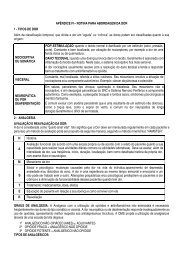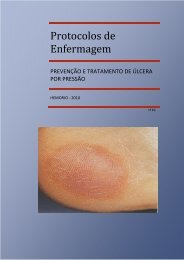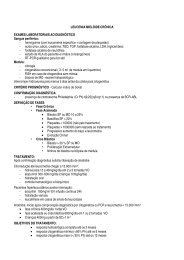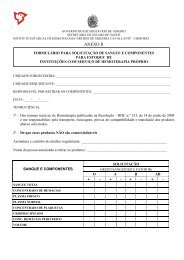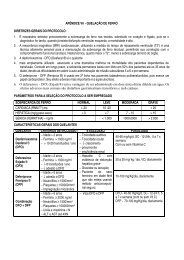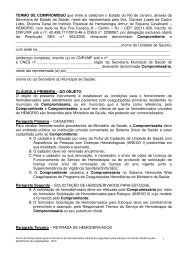Protocols - Hemorio
Protocols - Hemorio
Protocols - Hemorio
You also want an ePaper? Increase the reach of your titles
YUMPU automatically turns print PDFs into web optimized ePapers that Google loves.
NAUSEAS AND/OR VOMITS: Less than 50% of the subjects present nauseas and/or vomits. And usually,<br />
in the case of morphine, they present at the onset of the treatment. In the case of methadone, the<br />
presence of nauseas or vomits is a sign of toxicity, i.e., overdose. It indicates that the dose must be<br />
reduced to half or you must increase the interval (if it was every 6 h, turns to every 8h, provided that it is<br />
already been accumulated).<br />
At the subjects who also present constipation, in addition to nauseas and vomits, it is important to<br />
remember to discard intestinal obstruction.<br />
The chosen antiemetic is Haloperidol, in an dose in the morning of 1-2 mg (= 10 - 20 drops) + 5 drops at<br />
night SOS, because it acts right in the vomit center (exactly as the Morphine), it has a great action time<br />
and does not cause hypotension. The methochlopramide has an action for 4 h and may cause<br />
somnolence, agitation and extrapyramidal symptoms. The ondasentrone is too much expensive and its<br />
effect is better when the nausea is caused by chemotherapy.<br />
SOMNOLENCE, SEDATION: Both are more frequent at the onset of the treatment of chronic usage, until<br />
the tolerance is installed (subjects naïve to the treatment may take up to 7-10 days with this effect). For<br />
the treatment of algic, episode crisis, the sedation represents an initial sign of overdose, which anticipates<br />
the breathing depression. However, it may also mean sedation because he had his pain relieved after a<br />
plenty of hours suffering, and even not sleeping. The continuous usage and the experience of the<br />
physician and nurses will help recognizing it.<br />
In relation to Methadone, the somnolence is a sign of overdose, such as the nausea, which usually comes<br />
first.<br />
It is important to note that the usage of other drugs (antidepressant, another opioid, anticonvulsant,<br />
Benzodiazepine, antihistamine, among others) or other changes, such as Hyponatremia, changes of<br />
calcium, intracranial hypertension or anemia.<br />
HYPOTENSION: it may happen using the peridural path, if associated to a local anesthetic or if there is a<br />
concurrent usage with antihypertensive, diuretic, antidepressant, benzodiazepine, phenotiazidic or even if<br />
there is a dehydration setting. In such cases, the hypotension must be corrected in accordance to what<br />
has caused it.<br />
ABUNDANT SWEATING: It is not common to be caused by the usage of opioid. It is also observed at the<br />
abstinence syndrome or in subjects with hepatic failure. Prednisone or prednisolone (5-20 mg) may help.<br />
PHYSICAL DEPENDENCE – PSYCHIC DEPENDENCE AND ADDICTION: Physical dependence occurs<br />
in subjects that use opioid chronically, at a time higher than 15 days, and if discontinued abruptly it<br />
presents a reaction with sweating, midriasis, intense pains, muscle contractions, diarrhea, hyperthermia<br />
and behavioral change, aggressiveness. The physical dependence is due to a neuro-pharmacological<br />
reaction of the drug-receptor.<br />
207



